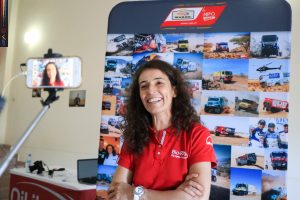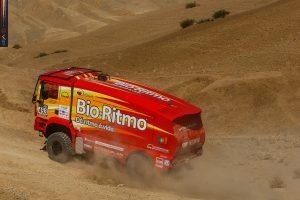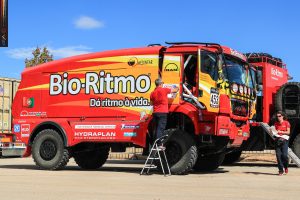 The Portuguese driver Elisabete Jacinto started today her participation in the Rallye Oilibya du Maroc, having finished in fifth place among trucks and in the 11th position of the Open category in the Super Special that had 12 timed kilometers and took place around Fez, in Morocco. The Bio-Ritmo® team fulfilled this short selective sector, which had the Argentine Frederico Villagra as winner of the T4, without any difficulty.
The Portuguese driver Elisabete Jacinto started today her participation in the Rallye Oilibya du Maroc, having finished in fifth place among trucks and in the 11th position of the Open category in the Super Special that had 12 timed kilometers and took place around Fez, in Morocco. The Bio-Ritmo® team fulfilled this short selective sector, which had the Argentine Frederico Villagra as winner of the T4, without any difficulty.
Elisabete Jacinto chose to perform this Super Special with some caution, in order to don’t compromise the race, because the winding mountain route wasn’t favorable to the trucks: “Today we made a short prologue in the region of Fez. It was a narrow mountain lane with many cliffs and huge holes. There were a lot of dangers and for us that compete in a truck things got even more complicated. So I decided to be more defensive because I didn’t want to make mistakes. When we have a long race ahead of us, it’s not worth risking, particularly on a course as short as we had today. I already know that the prologue is not my strong point because I take a while to adapt. So I preferred to enter with some caution but it all went well” explained the Portuguese driver.
 A significant note is that the pilot Elisabete Jacinto was honored yesterday by NPO, which organizes this rally, during the opening ceremony of the Rallye Oilibya du Maroc. As a way to mark the tenth anniversary of the event, the organization decided to award some motorcycle, car and truck drivers a distinction for their frequent participation, curriculum and also for the human values demonstrated during the ten years in which this rally took place. In addition to Elisabete Jacinto were also honored Paulo Gonçalves, Nasser Al-Attiyah, Bruno da Costa, Rafal Sonik, David Fratigne among others.
A significant note is that the pilot Elisabete Jacinto was honored yesterday by NPO, which organizes this rally, during the opening ceremony of the Rallye Oilibya du Maroc. As a way to mark the tenth anniversary of the event, the organization decided to award some motorcycle, car and truck drivers a distinction for their frequent participation, curriculum and also for the human values demonstrated during the ten years in which this rally took place. In addition to Elisabete Jacinto were also honored Paulo Gonçalves, Nasser Al-Attiyah, Bruno da Costa, Rafal Sonik, David Fratigne among others.
Tomorrow will be held the first stage of the Rally Oilibya du Maroc 2017 which will be disputed between Fez and Erfoud and will present a selective sector made of 367.18 kilometers. On this journey the tracks will alternate between stony paths and fast and winding tracks. The navigation will be particularly complex which will require extreme concentration of both pilots and co-pilots.



 The Portuguese driver Elisabete Jacinto and the Bio-Ritmo® team held today in Fez the administrative and technical checks of the Rallye Oilibya du Maroc which will start tomorrow, with a Super Special stage composed by 12 timed kilometers, and will end on October 10th in Erfoud, Morocco.
The Portuguese driver Elisabete Jacinto and the Bio-Ritmo® team held today in Fez the administrative and technical checks of the Rallye Oilibya du Maroc which will start tomorrow, with a Super Special stage composed by 12 timed kilometers, and will end on October 10th in Erfoud, Morocco. This edition of the Rallye du Maroc will be a real challenge for the Bio-Ritmo® team, as they will be competing against excellent teams, whose high budgets allow them to equip the trucks making them very effective and well prepared vehicles. Given this scenario, Elisabete Jacinto believes that the reliability, consistency and the team spirit will be the great assets to achieve the objectives: “Today is a day of great enthusiasm and expectation. It’s the day when we look at the other trucks and let ourselves be impressed by what we see. Based on this observation we try to predict the future and make guesses about the classification. On our part we are ready to give the maximum and we will fight for a good result. I hope that luck is on our side” said the Portuguese driver.
This edition of the Rallye du Maroc will be a real challenge for the Bio-Ritmo® team, as they will be competing against excellent teams, whose high budgets allow them to equip the trucks making them very effective and well prepared vehicles. Given this scenario, Elisabete Jacinto believes that the reliability, consistency and the team spirit will be the great assets to achieve the objectives: “Today is a day of great enthusiasm and expectation. It’s the day when we look at the other trucks and let ourselves be impressed by what we see. Based on this observation we try to predict the future and make guesses about the classification. On our part we are ready to give the maximum and we will fight for a good result. I hope that luck is on our side” said the Portuguese driver.